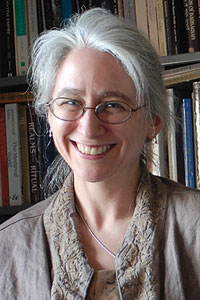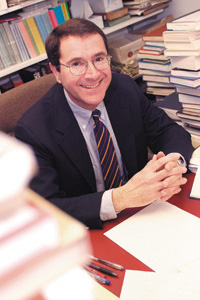Fellowships will further research of four scholars
By William Harms and Josh Schonwaldw-harms@uchicago.edu, jschonwa@uchicago.edu
News Office
 Photo by Bruce Powell Victor Friedman | |
Four University faculty members have received 2008 Guggenheim fellowships. They are among only 190 Guggenheim recipients chosen from 2,600 applicants in the United States and Canada.
Guggenheim fellows are appointed on the basis of distinguished achievement in the past and exceptional promise for future accomplishment. The new fellows include writers, painters, sculptors, photographers, filmmakers, choreographers, physical and biological scientists, social scientists, and scholars in the humanities. Many hold appointments in colleges and universities, with 89 institutions being represented by one or more fellows.
The four Chicago scholars who have received fellowships for research are Victor Friedman, the Andrew W. Mellon Professor in the Humanities and the College; Rachel Fulton, Associate Professor in History and the College; David Galenson, Professor in Economics and the College; and Donald Harper, Professor and Chairman of East Asian Languages & Civilizations.
Friedman, one of the world’s foremost scholars of Balkan linguistics, will use his Guggenheim fellowship to research a monograph on the similarities of one of the world’s most linguistically diverse and complex areas.
Friedman’s research, titled “On Speaking Terms: Multilingualism, Identities, and the Sociolinguistics of the Balkan Linguistic League,” builds on more than 30 years of research on Balkan linguistics. The co-author of The Balkan Languages, Friedman will center his research on Skopje, the capital of Macedonia. Skopje is a linguistic crossroads; the intersection of representative dialects of virtually every language in the Balkan linguistic league, which includes Romance languages (Romanian, Aromanian and Megleno-Romanian), Slavic languages (Bulgarian, Macedonian and dialects of the former Serbo-Croatian), Greek, Albanian, Balkan Turkish dialects, and Balkan dialects of Romani.
Friedman’s aim in centering his research on Skopje is three-fold: he seeks to provide a general historical background of the Balkans from a linguistic point of view, a survey of the rise of the Balkan standard languages and a detailed study of language contact in Skopje, where languages are in constant contact and competition.
“The resulting book will produce new knowledge about how language contact works in complex multilingual situations, in general, and about the Balkans, in particular,” wrote Friedman in his proposal.
 Photo by Beth Rooney Rachel Fulton | |
Friedman also has a broader goal to advance understanding among people in the regions. When he has lectured Albanians on the general principles of Balkan linguistics and Macedonians on Balkan verbal categories, both audiences were amazed at the structural similarities between the two languages. The students, Friedman explained, due to the influence of national ideologies and the compartmentalization of language instruction, were taught only differences and not shown the similarities that result from centuries of multilingualism.
Friedman’s study will be made available to audiences both in and outside of the Balkans and, he wrote, “it will thus contribute not only to the advancement of knowledge but also to the advancement of understanding among those who live in the region.”
Medievalist Rachel Fulton will use her Guggenheim fellowship to pursue a project on the Virgin Mary and prayer.
She will look at the cognitive and experiential aspects of prayer in monastic culture, with an emphasis on the practices that developed from the 10th to 15th centuries for prayer to the Trinity and the Virgin Mother of God.
Those practices included the recitation of the Little Office of the Blessed Virgin Mary, modeled on the monastic liturgy of the Hours, as well as meditation on the Joys and Sorrows of the Virgin through the recitation of the rosary.
“My immediate purpose is to find a way to describe monastic, Marian prayer as a practical art, that is, as a practice that takes skill and uses particular tools. My ultimate goal is to develop an understanding of the meaning and importance of worship as a creative act,” she said.
Fulton will work on a book that will look at how medieval Christians came to understand God through praying to the Virgin Mother. One of her objectives is to break down the divide that has developed among the disciplines of history and the sciences, such as the psychology of “what we know by thinking and what we know by doing, about religion as well as about ourselves,” she said.
She has published extensively on topics related to the Middle Ages and is the author of From Judgment to Passion: Devotion to Christ and the Virgin Mary, 800-1200.
 Photo by Dan Dry David Galenson | |
Why is 20th-century art so distinctively different from the art of its predecessors? Galenson will explore the question, using his Guggenheim fellowship to research an upcoming book. Galenson will analyze the ways in which 20th-century art departed from earlier art. The book, he said, will offer a “unified explanation of how and why artists created this work and behaved in these novel ways.”
Galenson hopes his work will not only make an original contribution to art history, but also will serve to make the some of the conceptual art of the 20th century intelligible to readers.
Galenson’s fellowship research builds on more than 10 years of empirical research in the history of Western art. His earlier books, Young Geniuses and Old Masters and Painting Outside the Lines, have demonstrated that artists produce innovations in two distinct ways, with different goals. “Experimental artists want to record their observations. They are uncertain how to do this, so they work incrementally, by trial and error,” Galenson said. “Their innovations occur late in their careers after long periods of study. By contrast, conceptual artists want to express ideas or emotions. With clear goals, they plan their work and execute it decisively.”
Experimental and conceptual innovators have coexisted throughout the history of Western art—Masaccio, Raphael and Caravaggio, for example, were conceptual innovators, while Leonardo, Michelangelo, Rembrandt and Velazquez were experimental innovators. “Yet a series of changes during the late-19th century,” Galenson wrote in his proposal, “including the decline of government patronage, the rise of a competitive market for fine art, and a growing demand for artistic innovation with the rise of modern art, freed artists to behave in more unconstrained ways.”
As a result, Galenson writes, “the 20th century was mostly driven by young iconoclastic conceptual innovators; analyzing these changes will be the focus of the book.”
Harper, who also is Director for the Center of East Asian Studies, will use his Guggenheim fellowship to continue research for his forthcoming book, Occult Texts and Everyday Knowledge in China in the Age of Manuscripts.
 Donald Harper | |
An expert on ancient and medieval Chinese religion, magic and science, Harper has written frequently on occult ideas and practices. His current project is based on numerous Chinese manuscripts, dated between the fourth-century B.C. and 10th-century A.D., that have come to light since the 20th century in archaeological excavations and chance discoveries. Focusing specifically on manuscripts of an occult nature—writings on astrology, divination and a diverse array of occult arts such as demonology and magic—Harper will examine how the occult knowledge recorded in the manuscripts affected everyday life.
Although occult knowledge circulated in writing and orally, the significance and durability of manuscript transmission across more than a thousand years exerted a determinative influence on ancient and medieval perceptions of that knowledge. From the perspective of ancient and medieval manuscript culture, manuscripts with occult content simultaneously supported and defined the reality of ordinary and unusual events that their content addressed, Harper explained in his proposal. Viewed from the perspective of modern research on the past, their content is directly relevant to historical anthropology, history of religion, history of science and intellectual history.
![[Chronicle]](/images/sidebar_header_oct06.gif)